- Region
- Águilas
- Alhama de Murcia
- Jumilla
- Lorca
- Los Alcázares
- Mazarrón
- San Javier
-
ALL AREAS & TOWNS
- AREAS
- SOUTH WEST
- MAR MENOR
- MURCIA CITY & CENTRAL
- NORTH & NORTH WEST
- TOWNS
- Abanilla
- Abarán
- Aguilas
- Alamillo
- Alcantarilla
- Aledo
- Alhama de Murcia
- Archena
- Balsicas
- Blanca
- Bolnuevo
- Bullas
- Cañadas del Romero
- Cabo de Palos
- Calasparra
- Camping Bolnuevo
- Campo De Ricote
- Camposol
- Canada De La Lena
- Caravaca de la Cruz
- Cartagena
- Cehegin
- Ceuti
- Cieza
- Condado de Alhama
- Corvera
- Costa Cálida
- Cuevas De Almanzora
- Cuevas de Reyllo
- El Carmoli
- El Mojon
- El Molino (Puerto Lumbreras)
- El Pareton / Cantareros
- El Raso
- El Valle Golf Resort
- Fortuna
- Fuente Alamo
- Hacienda del Alamo Golf Resort
- Hacienda Riquelme Golf Resort
- Isla Plana
- Islas Menores & Mar de Cristal
- Jumilla
- La Azohia
- La Charca
- La Manga Club
- La Manga del Mar Menor
- La Pinilla
- La Puebla
- La Torre
- La Torre Golf Resort
- La Unión
- Las Palas
- Las Ramblas
- Las Ramblas Golf
- Las Torres de Cotillas
- Leiva
- Librilla
- Lo Pagan
- Lo Santiago
- Lorca
- Lorquí
- Los Alcázares
- Los Balcones
- Los Belones
- Los Canovas
- Los Nietos
- Los Perez (Tallante)
- Los Urrutias
- Los Ventorrillos
- Mar De Cristal
- Mar Menor
- Mar Menor Golf Resort
- Mazarrón
- Mazarrón Country Club
- Molina de Segura
- Moratalla
- Mula
- Murcia City
- Murcia Property
- Pareton
- Peraleja Golf Resort
- Perin
- Pilar de la Horadada
- Pinar de Campoverde
- Pinoso
- Playa Honda
- Playa Honda / Playa Paraíso
- Pliego
- Portmán
- Pozo Estrecho
- Puerto de Mazarrón
- Puerto Lumbreras
- Puntas De Calnegre
- Region of Murcia
- Ricote
- Roda
- Roldan
- Roldan and Lo Ferro
- San Javier
- San Pedro del Pinatar
- Santiago de la Ribera
- Sierra Espuña
- Sucina
- Tallante
- Terrazas de la Torre Golf Resort
- Torre Pacheco
- Totana
- What's On Weekly Bulletin
- Yecla


- EDITIONS:
 Spanish News Today
Spanish News Today
 Alicante Today
Alicante Today
 Andalucia Today
Andalucia Today
The Cueva-sima de la Serreta, Cieza
The Cave of La Serreta, Cieza
An important cave containing prehistoric rock paintings in the Almadenes gorge, Cieza.
This is an interesting cave containing Neolithic rock art and Roman remains, which can be visited by prior 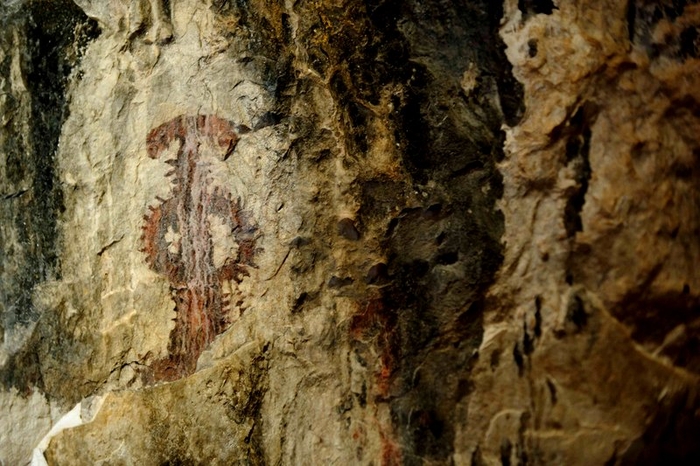 arrangement as part of a group visit to Cieza, and is also open during peak months of the year for visits by individuals or smaller groups.
arrangement as part of a group visit to Cieza, and is also open during peak months of the year for visits by individuals or smaller groups.
The cave, the cueva-sima de la Serreta, is located within the natural protected area of the river gorge of the Cañón de Almadenes. The gorge has been cut by the passage of the River Segura, creating vast sheer walls, 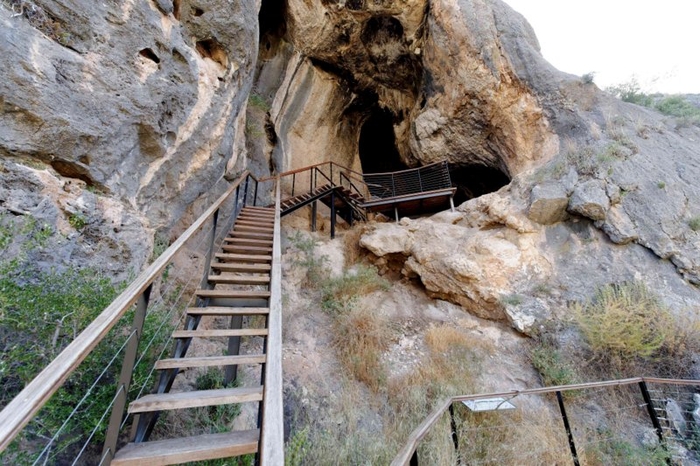 100 metres high in places.
100 metres high in places.
The natural porous nature of the limestone rocks from which the gorge is formed, has led to the formation of many natural caves and holes in the rocks around the area, creating a natural and attractive means of shelter for prehistoric man, as well as having the added advantage of abundant fresh water supplies.
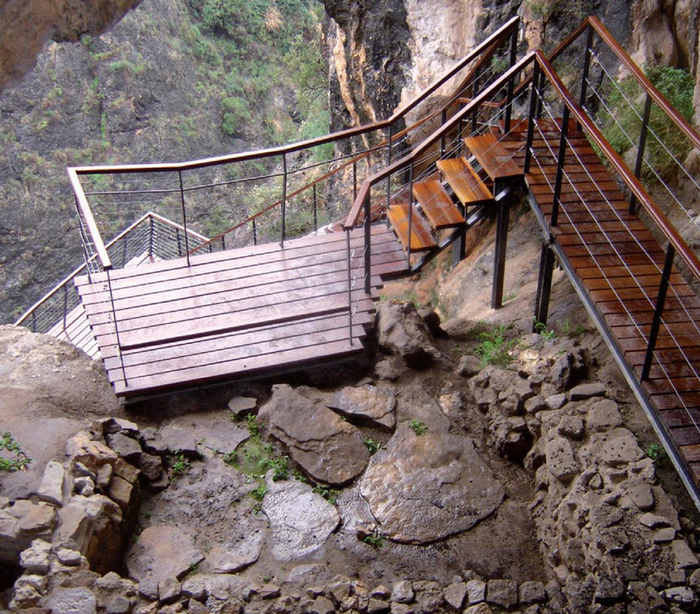 There are many caves within the municipality which show evidence of prehistoric occupation, and an abundance of not only archaeological remains including ceramics, flints and tools, but also natural rock-art paintings.
There are many caves within the municipality which show evidence of prehistoric occupation, and an abundance of not only archaeological remains including ceramics, flints and tools, but also natural rock-art paintings.
The Cueva de la Serreta is located on the left hand bank of the Los Almadenes gorge, and is virtually inaccessible from the canyon itself, but offers superb views of the canyon and the water below from its interior. The cave is accessed from a hole in the ground on the left hand bank of the gorge and historically would have been entered via a ladder or rope, before the creation of the existing spiral staircase which takes visitors down into the cave today.
The cave itself is 35 metres long and is 16 metres below the ground.
There are three main factors which make this cave such an important location and interesting place to visit: the spectacular view from its interior and location, the existence of Roman remains and the prehistoric rock art within the cave.
Neolithic occupation, Cueva de la Serreta
The first evidence of occupation dates back to the Neolithic, to a time known as the Middle Neolithic, which dates to approximately 4000-5000 BC. This is an interesting period as it marks the transition from hunter  gatherer to farmer, and there is evidence within this cave of both agricultural activity and the storing of foodstuffs as well as hunting activity.
gatherer to farmer, and there is evidence within this cave of both agricultural activity and the storing of foodstuffs as well as hunting activity.
Excavations within the cave reveal the presence of two storage silos which would have been used to store grain, a clear indication of farming activity, as well as two distinct hearths for cooking.
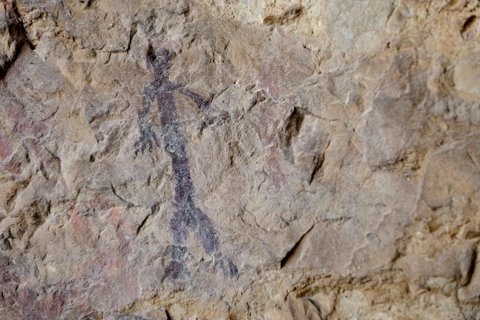 A large number of ceramic fragments have been excavated, some bearing incisions, indicating a deliberate intent to create decoration, grinding stone bases, which are in the characteristic boat shape created by constant pressure of grinding, as well as the top stones which would have been held in the hand and used to create friction, a bone necklace and a large quantity of stone fragments used to make stone objects. Amongst these are a number of stone bracelets, beautifully fashioned and smoothed by hand. There are replicas of the pieces found in the cave and the originals can be seen in the archaeological museum of Cieza.
A large number of ceramic fragments have been excavated, some bearing incisions, indicating a deliberate intent to create decoration, grinding stone bases, which are in the characteristic boat shape created by constant pressure of grinding, as well as the top stones which would have been held in the hand and used to create friction, a bone necklace and a large quantity of stone fragments used to make stone objects. Amongst these are a number of stone bracelets, beautifully fashioned and smoothed by hand. There are replicas of the pieces found in the cave and the originals can be seen in the archaeological museum of Cieza.
Rock art, Pinturas Rupestres
Within the cave there are also around 50 different rock paintings, for the large part, what is known as 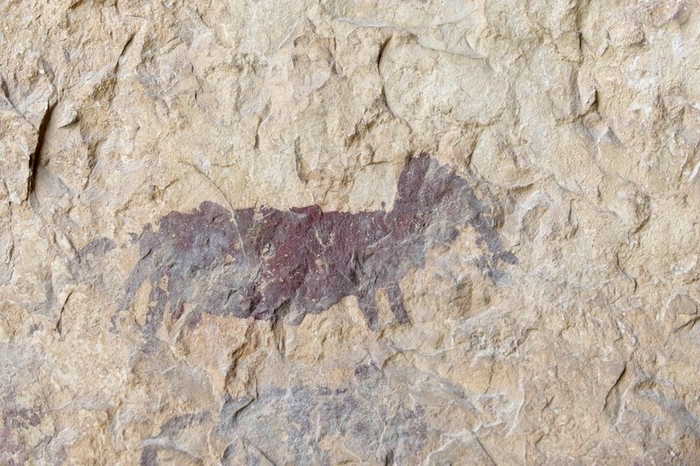 schematic rock art.
schematic rock art.
Schematic rock art is a form of art found widely across the Iberian peninsula ( Spain) and was prevalent during the 4th and 5th millennia BC. It is linked to the concept of realism and for the large part the paintings can be easily interpreted as taking a recognisable form, making the shapes into natural figures which are usually easily identifiable as natural forms, usually human figures or animals.
This classification also includes stylisation in which important figurative elements are distorted or accentuated to highlight an important aspect of the figure or abstraction, in which the figures are unconnected with reality, but which may have some sort of philosophical symbolism.
There are two distinct panels of art in the cave, one deeper inside the cave, which contains one particular  painting which has become known as the “idolo de la Serreta”, the idol of La Serreta, highlighted due to its size and possible status as a figure of some religious significance. The figure forms the shape of the greek symbol, phi, and the addition of lines emanating from the figure appear to indicate the radiance of some sort of power, or aura from the figure.
painting which has become known as the “idolo de la Serreta”, the idol of La Serreta, highlighted due to its size and possible status as a figure of some religious significance. The figure forms the shape of the greek symbol, phi, and the addition of lines emanating from the figure appear to indicate the radiance of some sort of power, or aura from the figure.
The second panel is much larger and is located closer to the natural opening of the cave, looking out over the canyon, and has a greater number of figures, amongst them clear representations of humans and animals, forming different scenes which seem to indicate both hunting and farming activities.During the excavations a grinding stone was also discovered which had been used to grind minerals and make the pigments which were subsequently mixed with animal fats to form paints which were applied to the walls to form these paintings.
Roman occupation of the Cueva de la Serreta
One of the most exciting aspects of this cave was the discovery that it had been used as a dwelling during the 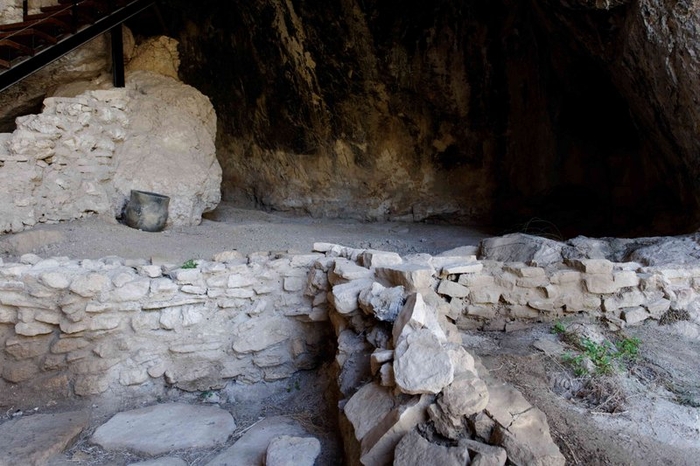 Roman period of occupation. Two distinct rooms had been constructed inside the cave, these being the only example found in Spain of Roman dwellings built inside a cave, and relate a period of instability as the Roman Empire began to crumble and the social and economic crisis of the 3rd century AD forced the occupants of Roman settlements and isolated villas to seek safety elsewhere.( Click for full History of Cieza)
Roman period of occupation. Two distinct rooms had been constructed inside the cave, these being the only example found in Spain of Roman dwellings built inside a cave, and relate a period of instability as the Roman Empire began to crumble and the social and economic crisis of the 3rd century AD forced the occupants of Roman settlements and isolated villas to seek safety elsewhere.( Click for full History of Cieza)
The cave appears to have been occupied during the latter period of the Roman occupation of the Iberian Peninsular, from the second half of the third century AD to the first years of the fourth century, so ties in with the instability sweeping across Spain at this time.
The first phase of occupation involved the construction of a room measuring 5 metres in length by 2.5 metres wide. Stone had been used to build a foundation, from which earth walls would have risen. Once this collapsed, it formed a base for the second phase of occupation. The second phase involved the construction of a slightly larger room on the foundations of the first and the addition of a second room, measuring  1.5metres square.
1.5metres square.
This room seems to have been tiled with small slabs of sandstone and also had a raised stone plinth, and the walls facing out into the gorge were thicker than the rest.
The roof appears to have been formed of wooden beams with a tiled covering over the top, excavations having revealed a good number of pieces of imbrex during the excavations. It would have been necessary to construct some form of roof covering, as water not only drove in from the opening of the cave, but also dripped in from above through fissures in the rock.
Archaeologists who excavated the site believe that it was abandoned voluntarily, due to the lack of materials found in the interior and the fact that the roof beams were taken out before the remainder of the shelter was set on fire.During excavations two complete Roman oil lamps were discovered, one decorated with erotic 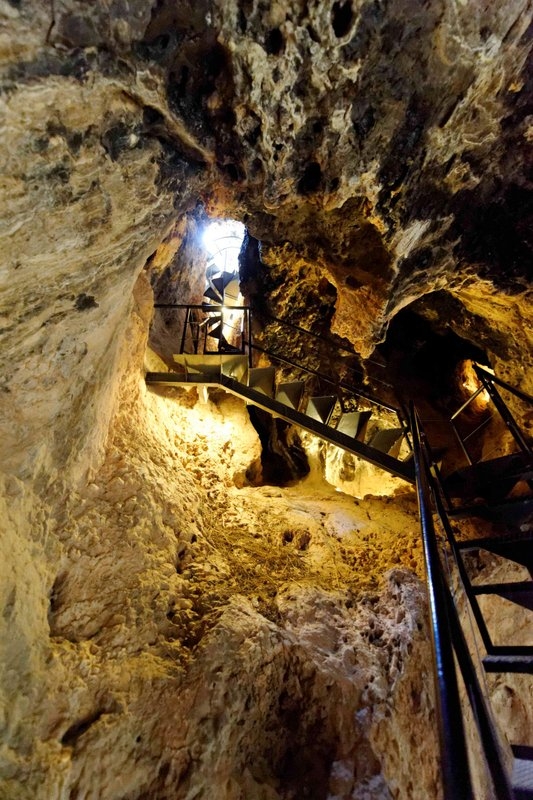 motifs and the other with a dolphin and two fishes, a bronze osculatorio with a stag on two bird heads with their beaks facing one another, some coins, an iron knife, three bronze medicinal pieces and a quantity of everyday ceramics.
motifs and the other with a dolphin and two fishes, a bronze osculatorio with a stag on two bird heads with their beaks facing one another, some coins, an iron knife, three bronze medicinal pieces and a quantity of everyday ceramics.
There is also evidence that the cave was used by shepherds following its abandonment as a Roman shelter, and up until very recently, shepherds would use the area inside the cool of the cave for the searing summer months.There is very little in the way of natural shelter in the area surrounding the cave, so shepherds would lower their flock into the hole using esparto grass cords, confining the animals to the rear of the cave during the hottest months of the year.
It’s a fascinating place to visit, and well worth the effort if a tour is offered.
Practicalities of visiting the Cueva de la Serreta, Cieza
The cave can only be visited with a guide by appointment. Group tours can be arranged for any time of the  year by prior arrangement, although it is advisable to avoid the hottest months of July-September. A visit to the cave can be combined with a tour of the old town, or a visit to the watermill. It is possible to visit Medina Siyasa in the same morning, but as it is interesting to see the old Arab town and the museum which recreates part of it in one visit, is perhaps better to make two separate trips to Cieza.
year by prior arrangement, although it is advisable to avoid the hottest months of July-September. A visit to the cave can be combined with a tour of the old town, or a visit to the watermill. It is possible to visit Medina Siyasa in the same morning, but as it is interesting to see the old Arab town and the museum which recreates part of it in one visit, is perhaps better to make two separate trips to Cieza.
Entrance to the cave is via a narrow spiral staircase and it is narrow, so anyone with mobility issues or nervous of narrow or enclosed spaces, is advised not to try and visit this location. Sensible flat shoes are a must.
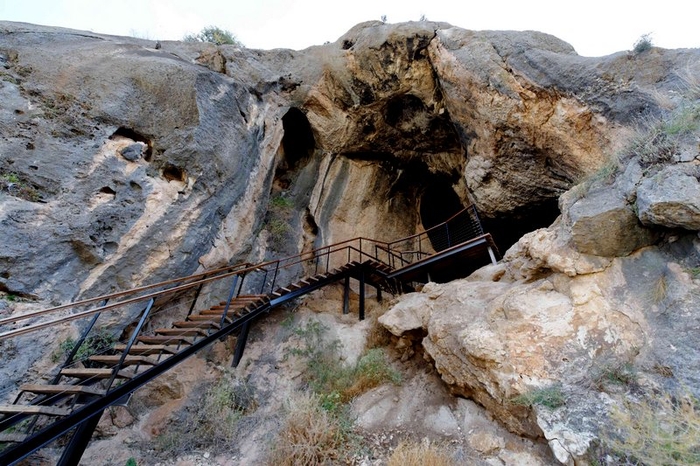 To book tours, contact the Tourist Office in Cieza
To book tours, contact the Tourist Office in Cieza
For more information about Cieza, go to the dedicated Cieza section, accessed via the map box at the bottom of every page, or the town search box at the top of every page.






































